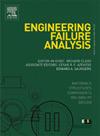Research on dynamic analysis and maintenance strategy for hard bending of high-speed turnout switch rail
IF 4.4
2区 工程技术
Q1 ENGINEERING, MECHANICAL
引用次数: 0
Abstract
Plastic deformation occurs in the turnout switch rail during loading, unloading, transportation, and storage, resulting in hard bending of the switch rail. The hard bending of the switch rail will lead to an abnormal increase in insufficient displacement, resulting in the geometric size exceeding the limit and the potential risk in the train operation. However, the dynamic simulation of the turnout area has not fully explored the potential impact of the insufficient displacement caused by the hard bending of the switch rail on driving safety. Therefore, this paper establishes a high-speed railway EMU-turnout dynamics model to evaluate the influence of the hard bending of the switch rail on the safety and stability of the train. The results show that the influence of theoretical and measured switch rail hard bending amplitude on the vehicle dynamics index is limited when it is 4 mm or less. However, when the hard bending amplitude of the switch rail increases to 8 mm, the relevant vehicle dynamics indexes increase significantly. The maximum derailment coefficients under the theoretical and measured hard bending of the 8 mm working conditions are 4.42 times and 6.71 times the normal working conditions, respectively. The wheelset lateral force is 4.55 times and 6.86 times the normal working conditions, but they are all within the safety limit. The on-site verification also confirms that there is no significant change in the vertical and lateral acceleration of the car body under the 4 mm hard bending of the switch rail. Finally, a maintenance strategy for the insufficient displacement caused by the hard bending of the switch rail is proposed and the effectiveness of the maintenance strategy is verified in the case study.
高速道岔转辙机钢轨硬弯曲动态分析与维护策略研究
道岔转辙器钢轨在装卸、运输和储存过程中会发生塑性变形,导致转辙器钢轨发生硬弯曲。道岔钢轨的硬弯曲会导致位移不足异常增加,导致几何尺寸超标,给列车运行带来潜在风险。然而,道岔区的动态仿真并未充分探讨道岔钢轨硬弯引起的位移不足对行车安全的潜在影响。因此,本文建立了高速铁路动车组-道岔动力学模型,以评估道岔钢轨硬弯曲对列车安全性和稳定性的影响。结果表明,当道岔钢轨硬弯幅度在 4 mm 或以下时,理论和实测的道岔钢轨硬弯幅度对车辆动力学指标的影响有限。然而,当道岔钢轨的硬弯曲幅度增加到 8 毫米时,相关的车辆动力学指标会显著增加。8 mm 硬弯曲工况下的理论和实测最大脱轨系数分别是正常工况的 4.42 倍和 6.71 倍。轮对侧向力分别是正常工作条件下的 4.55 倍和 6.86 倍,但都在安全限制范围内。现场验证还证实,在道岔轨道硬弯 4 毫米的情况下,车体的垂直加速度和横向加速度没有明显变化。最后,针对道岔导轨硬弯曲造成的位移不足提出了维护策略,并在案例研究中验证了维护策略的有效性。
本文章由计算机程序翻译,如有差异,请以英文原文为准。
求助全文
约1分钟内获得全文
求助全文
来源期刊

Engineering Failure Analysis
工程技术-材料科学:表征与测试
CiteScore
7.70
自引率
20.00%
发文量
956
审稿时长
47 days
期刊介绍:
Engineering Failure Analysis publishes research papers describing the analysis of engineering failures and related studies.
Papers relating to the structure, properties and behaviour of engineering materials are encouraged, particularly those which also involve the detailed application of materials parameters to problems in engineering structures, components and design. In addition to the area of materials engineering, the interacting fields of mechanical, manufacturing, aeronautical, civil, chemical, corrosion and design engineering are considered relevant. Activity should be directed at analysing engineering failures and carrying out research to help reduce the incidences of failures and to extend the operating horizons of engineering materials.
Emphasis is placed on the mechanical properties of materials and their behaviour when influenced by structure, process and environment. Metallic, polymeric, ceramic and natural materials are all included and the application of these materials to real engineering situations should be emphasised. The use of a case-study based approach is also encouraged.
Engineering Failure Analysis provides essential reference material and critical feedback into the design process thereby contributing to the prevention of engineering failures in the future. All submissions will be subject to peer review from leading experts in the field.
 求助内容:
求助内容: 应助结果提醒方式:
应助结果提醒方式:


